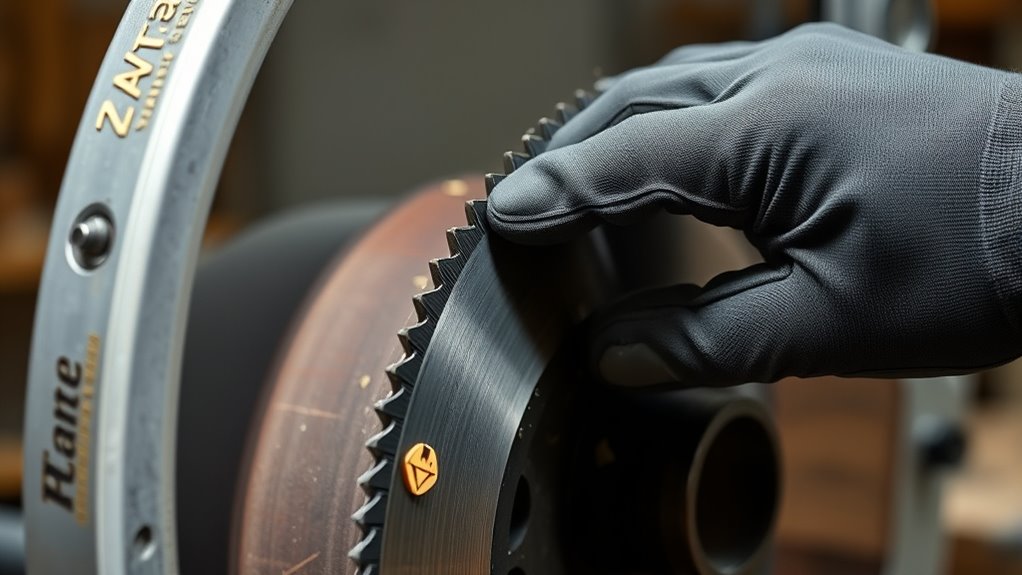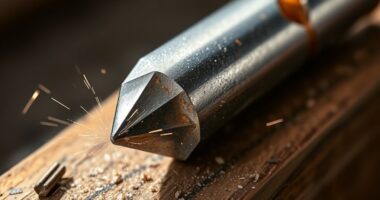To care for your bandsaw blade, regularly clean it with a brush or compressed air to remove debris and guarantee smooth operation. Check the tracking to make sure the blade runs centered on the wheels and adjust as needed for accuracy. Proper tension is essential—too loose or tight can cause issues—so use a tension gauge or follow your manual’s guidelines. Keep an eye out for signs of wear or damage to prevent accidents and maintain peak performance; learn more to master each step.
Key Takeaways
- Regularly clean the blade with a brush or compressed air to remove debris and resin buildup.
- Check and adjust the blade tracking to ensure it runs centered and smoothly on the wheels.
- Maintain proper blade tension, neither too loose nor too tight, using a tension gauge if available.
- Inspect the blade frequently for cracks, missing teeth, or excessive wear, and replace damaged blades immediately.
- Turn off and unplug the saw before performing any cleaning, tracking adjustments, or tensioning to ensure safety.

Proper bandsaw blade care is essential to guarantee accurate cuts, extend the blade’s lifespan, and maintain safety during operation. When it’s time to replace your blade, you need to follow proper procedures to ensure safety and avoid damaging your saw. Always turn off and unplug the machine before attempting blade replacement. Wear gloves to protect your hands from sharp edges, and use a brush or compressed air to clear debris from the blade area. Carefully loosen the blade tension and remove the old blade, making sure to handle it with care. Installing a new blade requires aligning it correctly on the wheels and ensuring the teeth face the right direction. Double-check the blade tension afterward to prevent slipping or excessive wear, which can lead to inaccurate cuts or safety hazards.
Safety precautions are critical during every aspect of bandsaw blade maintenance. When cleaning or adjusting the blade, keep your hands clear of the cutting area and use tools instead of fingers whenever possible. Before making any adjustments, always turn off and unplug the saw to prevent accidental startup. When inspecting the blade for damage, look for cracks, missing teeth, or excessive wear—that’s a sign you need a blade replacement immediately. Running a damaged blade risks catastrophic failure, which could cause serious injury or damage your equipment. Regularly checking blade tension and tracking also helps maintain safe operation, as a poorly tensioned or misaligned blade can wobble or break unexpectedly.
Tracking your blade properly ensures that it runs true along the wheels and doesn’t drift to one side. Misalignment not only affects cut quality but also increases the risk of accidents. To track the blade, turn on the saw at a low speed and observe its movement on the wheels. Adjust the tracking knob until the blade sits centered and runs smoothly. Proper tensioning is equally important; too loose, and the blade may slip or wobble, leading to poor cuts and potential safety issues. Too tight, and it can cause excessive wear or even break the blade. Consult your machine’s manual for the correct tension settings, and use a tension gauge if available. Regularly inspecting the blade’s condition, tracking, and tension helps you catch issues early, ensuring safer operations and better cuts.
Frequently Asked Questions
How Often Should I Replace My Bandsaw Blade?
You should replace your bandsaw blade when you notice decreased blade longevity, such as dull cuts, increased burning, or rough surfaces. Typically, the replacement frequency varies based on usage and material, but a good rule of thumb is every 6 to 12 months for regular use. Keep an eye on performance and replace the blade promptly to maintain precision and safety, preventing damage to your equipment.
What Types of Lubricants Are Safe for Bandsaw Blades?
You should use only recommended lubricant types that are safe for bandsaw blades, such as light machine oil or specialized blade lubricants. Always check blade compatibility before applying any lubricant to prevent damage or corrosion. Using the correct lubricant helps reduce friction, prolongs blade life, and ensures smooth cuts. Avoid harsh chemicals or WD-40, as they can harm the blade’s material and performance.
Can I Use Any Cleaning Solution on My Bandsaw Blade?
Like a knight tending to their armor, you shouldn’t use any cleaning solution on your bandsaw blade. Harsh cleaning solvents can cause blade corrosion or weaken the metal. Stick to gentle, blade-specific cleaners or a mixture of water and mild soap. This keeps your blade sharp and protected, ensuring it performs like a trusted sword in your workshop arsenal. Avoid anything too aggressive to preserve your blade’s longevity.
How Do Environmental Conditions Affect Blade Performance?
Environmental conditions considerably impact your bandsaw blade performance. High humidity can cause rust and corrosion, weakening the blade over time, while temperature fluctuations lead to expansion and contraction, affecting tension and tracking. To keep your blade in top shape, store it in a dry, stable environment and regularly check tension. Adjust your blade settings accordingly to account for temperature changes, ensuring smooth cuts and prolonged blade life.
Is It Necessary to Calibrate Tracking and Tension Regularly?
Yes, you should regularly calibrate tracking and tension to guarantee ideal blade performance. Proper blade alignment depends on consistent tension adjustment, which prevents wandering and uneven cuts. Check your saw’s tracking frequently, especially after changing blades or environmental changes. By maintaining correct tension and tracking, you reduce wear, improve cut quality, and extend your blade’s lifespan. Regular calibration keeps your bandsaw running smoothly and safely.
Conclusion
By keeping your bandsaw blade clean, properly tracked, and correctly tensioned, you’re giving it the best chance to perform like a well-oiled machine. Think of your blade as the heart of your saw—when it’s well-cared for, everything runs smoothly and efficiently. Regular maintenance isn’t just a chore; it’s the secret to safer, cleaner cuts and a longer-lasting blade. Treat your bandsaw blade like a trusted partner, and it’ll reward you with precision every time.









